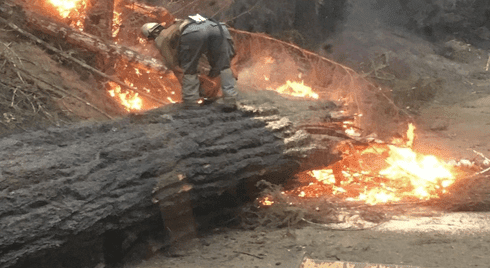National Saw Program
Save A Life!!

The Forest Service has a great motto: “Caring for the Land and Serving the People.”
This is a powerful foundation for building national programs.
In 2015 we were asked to help out with the US Forest Service’s National Saw Program. They had been meeting for the past 10 or so years working towards a new Saw Certification Program.
Like any national program that spans the full landscape the contrast is spectacular.
1. Giant Washington State Douglas Fir trees towering 175ft tall.
2. Enormous hollowed out Appalachian mountain hickory trees with wing spans of 120 feet.
3. Hostile scrub brush of New Mexico.
4. Wildland fires prescribed and raging out of control vs forest management.
Each species and landscape possesses its own unique pro tips and safe operating standards for Sawyers. Not to mention the certification includes 10,000 + Sawyers within the Forest Service and influences many other Nation’s fire and forest programs.
Imagine 40-70 confident saw leaders from every corner of the country getting together to build a national program, each with their own professional experiences and deeply embedded memories of success and failures, some sadly ending in fatalities. To save a life in one region could mean putting another Sawyer in harm’s way in another. One method doesn’t automatically translate safely into every situation.
How do you standardize a national program? Will standard methods and techniques work throughout the landscape? And if not, what regional, species or conditional variants are tolerable?
One practical example is deciding if one type of undercut should be the national standard. There are basically three undercuts to choose from. Each has its advantages. In my neck of the woods with “production falling” the standard is the Humboldt undercut. But in other regions and with some arborists the convention and open face are preferred.

Why is this important? Just go to YouTube and watch a couple of falling videos and you will quickly recognize that there is almost no standardization and from a safety standpoint. This is a massive liability.
How do you standardize a national program? For forest professionals who take their work and workmanship deadly seriously, to change a habit in the bush, it is going to take more than just an emailed memo outlining the “new national standard.”
This is where Switchback came in. We helped the program leaders process the complexity of their momentous task. Then we helped them find common ground to work as one team vs regional lobbying gangs. From these foundations they were able to develop the concept of a “New Thinking Sawyer” emphasizing risk management, human factors and Sawyer safety.
I know this might sound rudimentary but saving lives is deeply personal and very difficult to boil down to specifics and details concerning any task. Now consider a Sawyer cutting into a half rotten, smouldering tree at the end of a 14 day shift, in the heart of a fire with smoke and soot seeming to pass through the blood brain barrier.
It is at this very moment the NEW National Saw Training is put to the test. Will it inform and help guide the next move? For this to happen it’s a very difficult task.
Call to action: Do you have your own version of a “national program” that has been difficult to get off the ground because it requires a depth of understanding and teamwork to inform the moment when saving a life is exactly one thought away?
Are your current rules, regs and systems creating a “thinking workforce” or more of a liability cover over tick box?
Building a program that has teeth in the heat of the moment is harder than most of us think.
I encourage you to do the work… save a life.
Steven Falk

P.S. Don’t forget, People Can Change and The Power of Success is in TEAM

